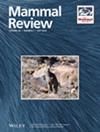Understanding causes of morbidity and mortality in Southern Hemisphere small Odontoceti: a scoping review
IF 4.4
2区 生物学
Q1 ECOLOGY
引用次数: 0
Abstract

了解南半球小型齿鲸发病和死亡的原因:范围界定审查
海洋哺乳动物是环境健康的哨兵,为生态系统健康提供洞察力。要加强对这些物种的管理和保护策略,就必须全面了解导致其发病和死亡的因素。本综述旨在确定南半球报告的小型齿鲸发病和死亡的原因。我们对文献进行了范围审查,搜索了 Scopus、PubMed 和 Web of Science,并对搜索中未包含的文章进行了额外的引文筛选。综述包括 198 篇文章,总样本量为 20 个属的 25567 头已死亡的小型齿鲸。出现的一个主要挑战是,39%的病例死因未定或不明。已知的缠绕占死亡总数的 47%。大规模搁浅(11%)和传染病(1.1%)也有报道。该研究在 276 只动物中发现了 14 种主要传染病病原体,包括病毒(CeMV = 214、H5N1 = 1)、细菌(布鲁氏菌 = 15、红斑病菌 = 1、猪链球菌 = 1、科贝肠杆菌 = 1)、寄生虫(弓形虫 = 15、卤虫 = 17、栉水母 = 1)。= 17、Clistobothrium grimaldii = 1、Stenurus globicephalae = 1、Giardia sp. = 1)和真菌(曲霉菌 = 2、巴西副球孢子菌 = 5、隐球孢子菌 = 1)。人类活动导致的死亡已成为南半球小型齿鲸的一个重大威胁,这表明迫切需要加强保护和管理策略。加强对传染性病原体的监测势在必行,其目的是加深我们对病原体分布、流行程度和对齿鲸健康影响的了解。
本文章由计算机程序翻译,如有差异,请以英文原文为准。
求助全文
约1分钟内获得全文
求助全文
来源期刊

Mammal Review
生物-动物学
CiteScore
12.20
自引率
4.10%
发文量
29
审稿时长
>12 weeks
期刊介绍:
Mammal Review is the official scientific periodical of the Mammal Society, and covers all aspects of mammalian biology and ecology, including behavioural ecology, biogeography, conservation, ecology, ethology, evolution, genetics, human ecology, management, morphology, and taxonomy. We publish Reviews drawing together information from various sources in the public domain for a new synthesis or analysis of mammalian biology; Predictive Reviews using quantitative models to provide insights into mammalian biology; Perspectives presenting original views on any aspect of mammalian biology; Comments in response to papers published in Mammal Review; and Short Communications describing new findings or methods in mammalian biology.
 求助内容:
求助内容: 应助结果提醒方式:
应助结果提醒方式:


